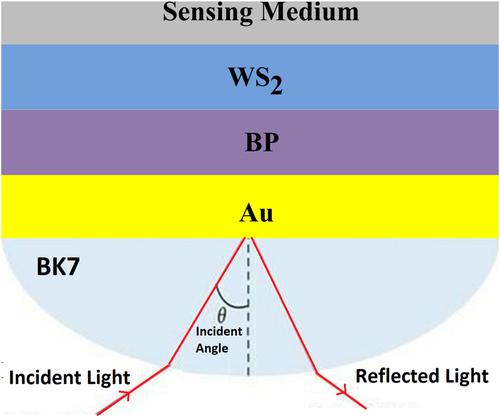当前位置:
X-MOL 学术
›
IET Optoelectron.
›
论文详情
Our official English website, www.x-mol.net, welcomes your
feedback! (Note: you will need to create a separate account there.)
Improving the performance of high-sensitivity surface plasmon resonance biosensor with 2D nanomaterial coating (BP-WS2) based on hybrid structure: Theoretical analysis
IET Optoelectronics ( IF 2.3 ) Pub Date : 2023-12-10 , DOI: 10.1049/ote2.12109 Rita Fatanat Didar 1 , Hamid Vahed 1
IET Optoelectronics ( IF 2.3 ) Pub Date : 2023-12-10 , DOI: 10.1049/ote2.12109 Rita Fatanat Didar 1 , Hamid Vahed 1
Affiliation

|
The authors theoretically designed a highly sensitive SPR biosensor with a hybrid structure using two-dimensional nanomaterials (BP-WS2). Using the transfer matrix method (TMM), the performance of the sensor in terms of reflection, sensitivity, detection accuracy, and quality factor is investigated, and by changing the structural parameters of the sensor, the obtained results are further analysed so that an optimal structure with optimal performance can be achieved. The sensor was optimised with four layers of BP and a single layer of WS2. This composite structure is placed on a 50 nm thick gold layer and concluded with a maximum sensitivity of 234 deg/RIU with a FOM of 26.53 RIU−1. This biosensor is designed by considering the advantages and characteristics of biosensors in their resistance and high electrical properties, as well as the ability to detect diseases quickly.
中文翻译:

基于混合结构的二维纳米材料涂层(BP-WS2)提高高灵敏度表面等离子体共振生物传感器的性能:理论分析
作者利用二维纳米材料(BP-WS 2 )从理论上设计了一种具有混合结构的高灵敏度SPR生物传感器。采用传输矩阵法(TMM)研究传感器在反射率、灵敏度、检测精度和品质因数等方面的性能,并通过改变传感器的结构参数,对所得结果进行进一步分析,从而得到最优的传感器结果。可以实现具有最佳性能的结构。该传感器采用四层 BP 和单层 WS 2 进行优化。该复合结构放置在 50 nm 厚的金层上,最大灵敏度为 234 deg/RIU,FOM 为 26.53 RIU −1 。该生物传感器的设计考虑了生物传感器的电阻和高电性能以及快速检测疾病的能力等优点和特点。
更新日期:2023-12-10
中文翻译:

基于混合结构的二维纳米材料涂层(BP-WS2)提高高灵敏度表面等离子体共振生物传感器的性能:理论分析
作者利用二维纳米材料(BP-WS 2 )从理论上设计了一种具有混合结构的高灵敏度SPR生物传感器。采用传输矩阵法(TMM)研究传感器在反射率、灵敏度、检测精度和品质因数等方面的性能,并通过改变传感器的结构参数,对所得结果进行进一步分析,从而得到最优的传感器结果。可以实现具有最佳性能的结构。该传感器采用四层 BP 和单层 WS 2 进行优化。该复合结构放置在 50 nm 厚的金层上,最大灵敏度为 234 deg/RIU,FOM 为 26.53 RIU −1 。该生物传感器的设计考虑了生物传感器的电阻和高电性能以及快速检测疾病的能力等优点和特点。

































 京公网安备 11010802027423号
京公网安备 11010802027423号